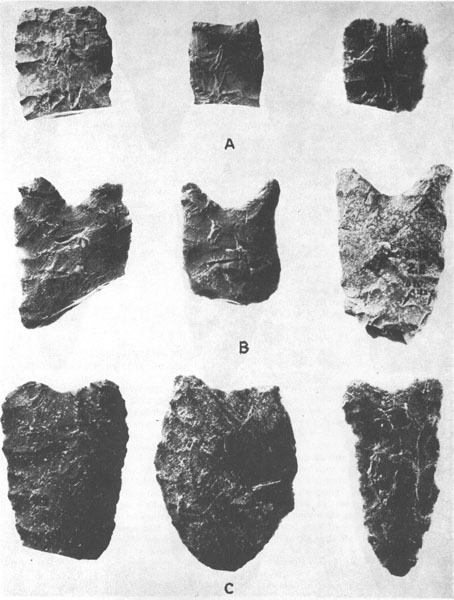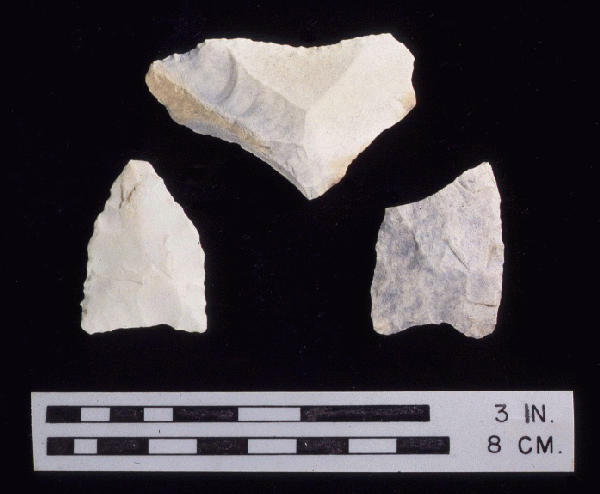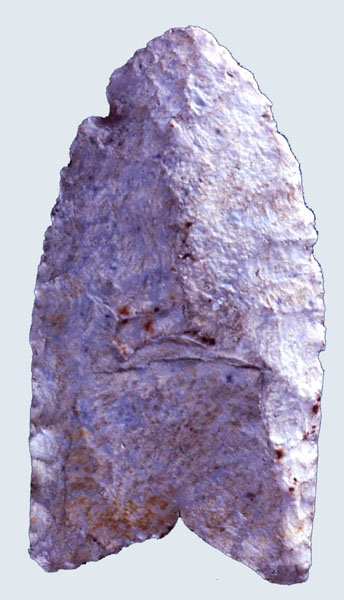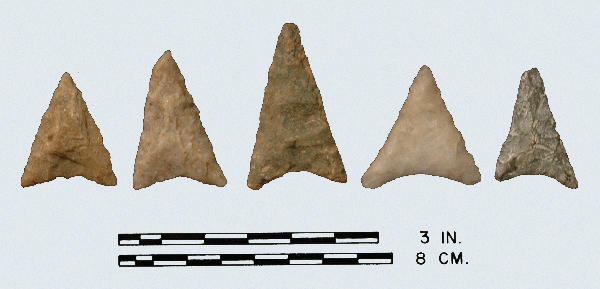
Hardaway Blade: from Coe 1964, page 65.

Hardaway Blade: 44SX0202 Nottoway River Survey, Lithic Casting Laboratory, replicas. Bottom Row: tuff, rhyolite.
Type Lanceolate Paleo-Indian
Defining Attributes
A Hardaway Blade consists of a broad, thin blade with a concave and thinned base. Most Hardaway Blades have their greatest width at the base; however few appear roughly pentagonal with their greatest width about halfway between the base and the point.
Chronology
The Hardaway Blade dates to the Paleo-Indian period, perhaps as early as 10,000 BCE, if one assumes that it is related to pre-Clovis occupation. There is considerable variation among the points discussed by Coe (1964), however most all of these forms were recovered from the lowest level excavated at the Hardaway Site in North Carolina. Coe (1964) notes that the Hardaway Blade is the earliest point type to be excavated in North Carolina.
Description
- Blade: A broad and thin blade with rounded sides. Also, the blade usually has a dull or rounded point.
- Base: Usually concave (but occasionally straight) bases. Corners of the base sometimes flare outward. The base is thinned and flake scars occasionally extend well down the face of the blade. Basal grinding is rare.
- Size: Length ranges from 50 to 80 mm with an average of 70 mm. Width ranges from 23 to 50 mm with an average of 40 mm. Thickness ranges from 5 to 12 mm with an average of 8 mm.
- Technique of manufacture: The Hardaway Blade is characterized by broad, shallow flakes that extend well into the center of the blade, which appear to have been made by direct percussion. Very little retouching or secondary chipping occurs.
Discussion
Most of the Hardaway Blades were recovered embedded four to six inches in the clay subsoil at the Hardaway Site. A similar flaring of the base occurs in the northern Alabama Quad point (Soday 1954), central Tennessee, and across the Mississippi in Missouri on blades that generally are narrower and that tend to merge with the Dalton form. McAvoy (1997) recovered a similar early pentagonal biface, too thin to permit fluting, from a pre-Clovis horizon, as early as 11,000 BCE, at the Cactus Hill Site, Virginia. McAvoy (1979) had recognized in 1965 a similar point style which he called, Appomattox River Point, from the Point-of-Rocks site in Chesterfield County. At the time McAvoy placed the point style in the late Paleo-Indian period.
Defined in Literature
Coe (1964) originally defined the type based on points recovered from the Hardaway Site in the Piedmont of North Carolina.
References



